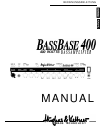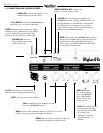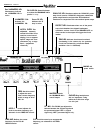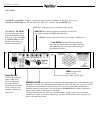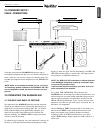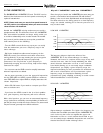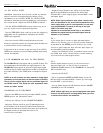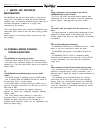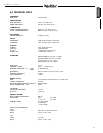
BASSBASE 400
-
MANUAL
3.3 THE NOTCH FILTER
Undesirable frequencies such as those caused by resonant
object in the room or floor boards in the stage can be
suppressed via the NOTCH FILTER. The NOTCH FILTER
operates in extremely narrow bandwidths to avoid altering
the overall sound. Adjust the NOTCH FILTER as follows:
-
Turn the NOTCH FILTER LEVEL control all the way up so
you can clearly hear the attenuated frequency.
-
Turn the FREQUENCY knob until you locate the frequency
responsible for the sympathetic vibrations; the NOTCH
FILTER will suppress it.
-
Now can turn the LEVEL control just below the point
where the resonance sets in, thus ensuring that the filter has
a minimal effect on the overall sound.
It does take a bit of practice to get the hang of the NOTCH
FILTER, as the human ear cannot readily identify attenuated
narrow bandwidths.
3.4 THE
BASSBASE
400 AND FX PROCESSORS
The
BASSBASE
400 is equipped with a parallel FX loop. The
processed signal is mixed with the original signal (i.e. the
BASSBASE
preamp signal) so that the original signal is still
audible during the brief interruptions caused by multieffects
processor switching. The FX-MIX knob controls the dry/wet
mix.
NOTE: As a rule of thumb, the best method for using signal
processors is to set the device so that its output is all effect,
then to mix the original signal with the processed signal via
the FX-MIX control. This avoids the tone degradation often
caused by effects devices.
CONNECTING AN FX PROCESSOR:
-
Connect the SEND jack to the processor’s INPUT, and the
RETURN jack to the processor’s output.
-
Activate the FX loop via the FX SELECTOR SWITCH.
-
Adjust the FX loop’s level to your FX processor’s input
level. Press the -10 db button for effects devices that are
designed for instrument levels. If the button is not pushed in,
the signal remains at standard line level for 19”
rackmounted processors.
-
Adjust the blend between the original and processed
signal via the FX MIX pot located on the front panel
Towards DRY = more original signal, towards WET = more
processed signal.
NOTE: Some signal processors cause phase cancella tions
that are detrimental to the overall sound (washed-out tone,
lower output level at the 12 o’clock position). In this case,
turn the
BASSBASE
FX control all the way to the right
(WET). The effects loop then
operates as a conventional serial loop, i.e. the balance
between the original and the processed signal must be
adjusted at the processor.
TIP 1:
If you choose not to connect a signal processor/effects
device to the FX loop, you can connect another instrument
or
tape
deck at the RETURN jack. For instance you could
connect a guitar, keyboard, drum machine, tape player, etc.
for rehearsals or practice sessions.
-
Connect the additional device as described above and use
the FX-MIX knob as the volume balance control between
your bass and the external signal source.
TIP 2:
Another option is open to you if you do not connect a
signal processor: You can use the loop to activate an
additional MASTER volume for the BASSBASE. To use the FX
MIX control this way:
-
Activate the FX LOOP.
-
Dial in a separate MASTER VOLUME setting via the FX
MIX pot (to the left towards DRY = volume up, to the right
towards WET = volume down).
-
You can switch back and forth between the two MASTER
VOLUMES via the FX footswitch.
NOTE: Please make sure you set the appropriate front panel
button to the OFF position (not depressed) when you want
to activate this function via footswitch.
9



